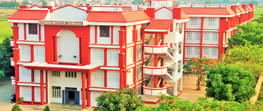Ankit Kumar has been working as the Lecturer in the Civil Engineering Department at Satyam International Institute of Technology, Patna, Bihar. As part of his education, he has done B.Tech from KK College of Engineering, M. Tech from BIT Sindri in 2022, Diploma from Kk Polytechnic of Dhanbad in 2017 and is pursuing PhD from NIT Patna. His specializations are Geotechnical Engineering and he has also done training in CIMFR CSIR. His total teaching experience is 12 years and he has also published a research paper on the subject of “Stabilization of clayey soil using Crumbled rubber and tiles powder” in a reputed journal.

What approaches have you adopted to fulfill the diverse academic needs and styles of students?
As an experienced Teacher, I understand the importance of catering to the individual needs of my students. Hence, we as educators have built a diverse, vibrant and inclusive learning environment on campus for students benefit and also keep tweaking our pedagogies and instructional strategies to suit their different learning styles and abilities. First and foremost, I use visual aids and hands-on activities and have also integrated the latest technologies in the curriculum to deliver them the finest quality and employment-oriented knowledge. Apart from this, I regularly assess my students to understand their strong areas and weaknesses and accordingly provide them required support as and when needed.
How do you encourage good behavior and a disciplined environment among students?
It’s a well-known fact that effective classroom management is very crucial for creating a positive and productive learning environment. Therefore, to promote good behavior and discipline among students, we set clear expectations and rules from the beginning of the year and constantly encourage students to follow them. In addition to this, positive reinforcement techniques like praises and rewards are used to acknowledge students achievements and motivate them to achieve more. Last but not the least, I employ a fair and consistent approach which is focused on teaching students’ appropriate behavior and helping them reflect on their actions.
In your opinion, how and why a Civil Engineer is the backbone of the construction industry?
In today’s modern., dynamic and highly interconnected world, a Civil Engineer plays a crucial role in the construction industry by designing, planning and overseeing various infrastructure projects such as roads, bridges, buildings and water supply systems. They are also responsible for ensuring the structural integrity, safety and functionality of these projects. Additionally, they work closely with Architects, Contractors and Government Agencies to ensure compliance with building codes and regulations. Hence, they are, were and will be in demand in the upcoming future as nations are investing heavily on strengthening their existing infrastructure projects and building new ones.
Check SIIT News & Articles
Which key skills and qualifications should a Civil Engineer possess?
Depending on the requirements of society and developments happening in the industrial world, a Civil Engineer should have a strong foundation in subjects like Mathematics and Physics, as well as they should possess in-depth understanding of Engineering principles and design concepts. They should also be proficient in using computer-aided design (CAD) software and other relevant technical tools. Lastly, excellent problem-solving and critical-thinking skills are essential, as civil engineers often encounter complex challenges during the design and construction phases. Additionally, effective communication and teamwork abilities are crucial for collaborating with various stakeholders and managing construction projects efficiently.
What key factors do you consider when designing a structure to ensure its safety and durability?
As a Civil Engineer, safety and durability are of utmost importance in my designs. And I consider various factors such as the structural integrity of materials used, load-bearing capacity, environmental conditions, and adherence to building codes and regulations, while designing a structure. Apart from this, I pay undivided attention to parameters like seismic activity, wind resistance, and potential natural disasters to ensure the structure can withstand such events.
What was the most challenging project you have worked on so far and how did you overcome the obstacles faced during its construction?
One of the most challenging projects I have ever worked on was the construction of a bridge over a major river. And due to strong river currents and the need to minimize the disruption to the water flow during construction, we faced many difficulties at different levels. And to overcome these hurdles, we had conducted extensive hydrological studies, implemented innovative construction techniques and collaborated closely with Hydraulic Engineers. In addition to this, we had incorporated specialized design elements and used precast concrete segments to successfully complete the project while ensuring minimal impact on the river’s ecosystem.



 (1).png?h=132&w=263&mode=stretch)

.png?h=132&w=263&mode=stretch)




 (1).png?h=78&w=78&mode=stretch)

.png?h=78&w=78&mode=stretch)
![IIT Patna - Indian Institute of Technology - [IITP]](https://image-static.collegedunia.com/public/college_data/images/appImage/1491982439ainmg.jpg?h=111.44&w=263&mode=stretch)

![National Institute of Technology - [NITP]](https://image-static.collegedunia.com/public/college_data/images/appImage/25417_NITPATNA.jpg?h=111.44&w=263&mode=stretch)

![Birla Institute of Technology - [BIT]](https://image-static.collegedunia.com/public/college_data/images/appImage/1493615792123.jpg?h=111.44&w=263&mode=stretch)

![Bakhtiyarpur College of Engineering - [BCE]](https://image-static.collegedunia.com/public/college_data/images/appImage/1572427140IMG20170520WA0008.jpg?h=111.44&w=263&mode=stretch)

![Maulana Azad College of Engineering and Technology - [MACET]](https://image-static.collegedunia.com/public/college_data/images/appImage/1493361579cvr.png?h=111.44&w=263&mode=stretch)







 (1).png?h=72&w=72&mode=stretch)

.png?h=72&w=72&mode=stretch)
.png?h=72&w=72&mode=stretch)



![Government Polytechnic Gulzarbagh - [GPP]](https://image-static.collegedunia.com/public/college_data/images/logos/1598521213gpplogo.png?h=72&w=72&mode=stretch)

![Sandip Foundation's Shri Ram Polytechnic -[SRP]](https://image-static.collegedunia.com/public/college_data/images/logos/1599450619srplogo.jpg?h=72&w=72&mode=stretch)
![J P Institute of Technology - [JPIT]](https://image-static.collegedunia.com/public/college_data/images/logos/1599467406jplogo.jpg?h=72&w=72&mode=stretch)



![Netaji Subhas Institute of Technology - [NSIT]](https://image-static.collegedunia.com/public/college_data/images/logos/1478670987logo-NSIT.png?h=72&w=72&mode=stretch)
![Patna Sahib Group of College - [PSGC]](https://image-static.collegedunia.com/public/college_data/images/logos/1487070165logoedt.png?h=72&w=72&mode=stretch)

![New Government Polytechnic - [NGP]](https://image-static.collegedunia.com/public/college_data/images/logos/1596184338logon.jpg?h=72&w=72&mode=stretch)
![Aryabhatta Knowledge University - [AKU]](https://image-static.collegedunia.com/public/college_data/images/logos/1492759018AKUBiharLogo.jpg?h=72&w=72&mode=stretch)




Comments